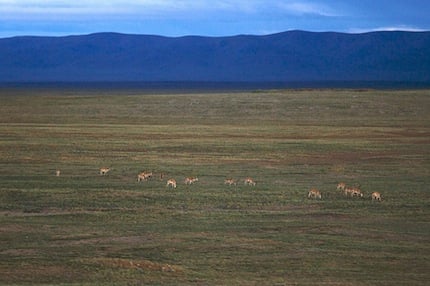In the musty back room of the Kashmiri handicrafts store in Islamabad’s main Jinnah market, the shopkeeper reaches behind the counter with the keys to open a concealed black suitcase. He retrieves half a dozen luxury shawls made from the fur of an endangered antelope, which are so fine they can be passed through a ring.
The shahtoosh shawls – the Persian word means “king of wools” – are delicate, incredibly soft and unstained. But the trade in these shawls, which appear to be new, is illegal.
Shahtoosh shawls are made by highly skilled Kashmiri artisans from the fine under-fur of the chiru (the Tibetan antelope) and they are prized in Pakistan. Processing or wearing shahtoosh is a punishable offence in India, and in Pakistan – where they are smuggled into from Indian Kashmir – anyone selling them face prison sentences of up to two years and fine of up to Rs1m (£5,805). International trade in the Tibetan antelope is also banned under the Convention on International Trade in Endangered Species (Cites), to which Pakistan is a signatory.
Despite these controls, possessing a shahtoosh shawl is still a status symbol among the rich elite. During the winter months the brown-beige shawls are worn by men and women, and can be seen draped over many a sari and salwar kameez at lavish weddings and dinner parties at exclusive venues. “Most of our clients are Pakistanis, not foreigners. They appreciate the true value of these shawls,” points out the shopkeeper, proudly displaying a rare creamy white shahtoosh, on sale for US$4,000.
The ubiquitous Kashmiri handicrafts stores in Islamabad are aware of the law, hence the shawls are not openly displayed but only brought out for “serious buyers”, which are often well-heeled mothers keen to buy these delicate shawls for the daughter’s dowry. Shahtoosh shawls have traditionally been given as wedding gifts in India and Pakistan. “I know about the law, but my daughter will only wear it in Pakistan and I really want her to have one; it is a collector’s item. Sadly mine got stolen a few years ago,” explains banker Ayesha Khan, whose daughter will be getting married in October this year.
The issue recently came to the fore when a young designer with flagship stores in Lahore and Karachi advertised a collection of shahtoosh shawls across the country. Nida Azwer was quoted saying of her ‘Toosh collection’: “Look, it’s not completely shahtoosh, it’s mixed with pashmina. I don’t feel controversial about it and nobody else does either.” She has since been lauded by the mainstream media in Pakistan for “seeing the gap in the market” with the “intent to make something this valuable readily available.”
But Azwer told the Guardian that even though her shawls used the shahtoosh name, they were made from sheep wool and pashmina, not the fur of the chiru. She said: “These shawls have been purchased from the local market, where they are freely sold … I have not imported any such material which is related to shahtoosh”. Out of the 30 shawls she had bought, she says she has sold only five after doing her “own brand of embroidery work” on them, and says she has not violated any laws.
WWF-Pakistan said it had sent Nida Azwer a complaint letter and notified the provincial wildlife authority. “A couple of years ago we pursued a fashion designer who was promoting fox furs and other kinds of fur from wild animals. We plan to fully investigate this case as well,” says Uzma Khan, biodiversity director at WWF-Pakistan.
Nuzhat Saadia Siddiqi, an environmentalist and activist, said: “The prestige factor may be high with shahtoosh, but it is false prestige, standing on the carcasses of dead animals. Anyone wearing, buying, selling, gifting shahtoosh shawls should be ashamed of themselves.”
The demand for shahtoosh has already pushed the chiru to the brink of extinction. The antelope must be killed for the fur to be collected, and it takes around four chiru to make a single shawl.
The chiru’s population declined by more than 50% during the past 20 years of the 20th century. The WWF estimates there remains a small migratory population of around 75,000-100,000, but the antelope’s status is still endangered. “That is not a huge population for an antelope, especially a slow-breeding one like the chiru,” said Khan. “They give birth to one offspring per year and half of those die within two months of their birth.”
Chiru are inhabitants of Tibet and they migrate to Ladakh in India in the summer months. They are already extinct in Nepal.
This article was first published on The Guardian. It is republished here with permission.

